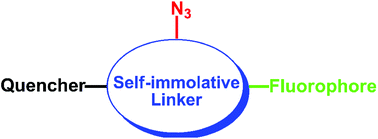Chemoselective reduction and self-immolation based FRET probes for detecting hydrogen sulfide in solution and in cells†
Abstract
Hydrogen sulfide (H2S) has been regarded as the third gaseous transmitter. Based on the mechanism of chemoselective azido reduction and self-immolation, five fluorescence resonance energy transfer (FRET) probes for the detection of H2S were designed and synthesized. The effect of functional substitution of the self-immolative moiety on azido reduction and quinone-methide rearrangement were investigated. Their fluorescence responses and chemoselectivity for H2S detection were evaluated in solutions and in cells. This strategy may provide a general route for designing H2S probes with many commercially available FRET pairs.


 Please wait while we load your content...
Please wait while we load your content...